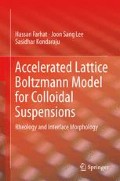Abstract
This chapter presents a novel phenomenological approach for suppressing the coalescence in the Gunstensen multicomponent lattice Boltzmann method (LBM). The suppression of coalescence is achieved by perturbing the terminal nodes of the ambient fluid’s thin layer trapped between the approaching droplets. This additional perturbation creates a local high pressure fluid layer which eventually leads to suppressing the coalescence of the neighboring droplets while maintaining a suitable qualitative force balance representative of the physical intermolecular forces which act between them. The suppression of coalescence enables predicting the rheological properties of soft colloids, which is one of the most challenging and complicated problems in material and fluid sciences. Substantial complications in prediction of rheology arise due to the deformability and aggregation of soft colloids. Thus, a better understanding to deformation and aggregation of colloids can lead to a better understanding of the shear thinning region of colloidal solutions. This chapter provides a practical overview of the deformation and de-aggregation of droplets with change in time or increase in shear rate. Simulations performed here are used to quantify (a) relative viscosity of emulsions with change in shear rate, (b) relative viscosity of emulsions with change in time, (c) effect of deformation of droplets on the shear thinning region in emulsions, and (d) relative viscosity of emulsions with change in volume fraction.
Access this chapter
Tax calculation will be finalised at checkout
Purchases are for personal use only
References
Bedeaux D (1983) The effective shear viscosity for two-phase flow. Phys A Stat Theor Phys 121:345–361
Chandran KB, Rittgers SE, Yoganathan AP (2007) Biofluid mechanics: the human circulation, 1st edn. CRC, Abingdun, UK, Ch. II
Chauveteau G, Omari A, Tabary R, Renard M, Rose J (2000) Controlling gelation time and microgel size for water shutoff. SPE 59317 SPE/DOE improved oil. doi: 10.2118/59317-MS
Derksen JJ, Eskin D (2010) Potential of microchannel flow for agglomerate breakage. Ind Eng Chem Res 49:10633–10640
Dupin M, Halliday I, Care C (2003) Multi-component lattice Boltzmann equation for mesoscale blood flow. J Phys A Math Gen 36:8517–8534
Escudier MP, Gouldson IW, Pereira AS, Pinho FT, Poole RJ (2001) On the reproducibility of the rheology of shear-thinning liquids. J Non-Newton Fluid Mech 28:99–124
Farhat H, Celiker F, Singh T, Lee JS (2011) A hybrid lattice Boltzmann model for surfactant-covered droplets. Soft Matter 7:1968–1985
Halliday I, Hollis A, Care C (2007) Lattice Boltzmann algorithm for continuum multicomponent flow. Phys Rev E 76:026708-1–026708-13
Hashim Z, Shtrikman S (1963) A variational approach to the theory of the elastic behaviour of multiphase materials. J Mech Phys Solids 11:127–140
Hsueh C, Wei W (2009) Analyses of effective viscosity of suspensions with deformable polydispersed spheres. J Phys D Appl Phys 42:075503
Ladd AJC (1990) Hydrodynamic transport coefficients of random dispersions of hard spheres. J Chem Phys 93:3484–3495
Lyu S, Jones T, Bates F, Macosko C (2002) Role of block copolymers in suppression of droplet coalescence. Macromolecules 35:7845–7855
Mason TG, Bibette J, Weitz DA (1996) Yielding and flow of monodisperse emulsions. J Colloid Interface Sci 72:439–448
Omari A, Chauveteau G, Tabary R (2003) Gelation of polymer solutions under shear flow. Colloid Surf A Phys Chem Eng Aspects 225:37–48
Pal R (1996) Multiple O/W/O emulsion rheology. Langmuir 12:2220–2225
Pal R (2000) Shear viscosity behavior of emulsions of two immiscible liquids. J Colloid Interface Sci 225:359–366
Pal R (2001) Single-parameter and two-parameter rheological equations of state of nondilute emulsions. Ind Eng Chem Res 40:5666–5674
Peixinho J, Karanjkar PU, Lee JW, Morris JF (2010) Rheology of hydrate forming emulsions. Langmuir 26:11699–11704
Phan-Thien N, Pham D (1997) Differential multiphase models for polydispersed suspensions and particulate solids. J Non-Newton Fluid Mech 72:305–318
Tolpekin VA, Duits MHG, van den Ende D, Mellema J (2004) Aggregation and breakup of colloidal particle aggregates in shear flow. Langmuir 20:2614–2627
Author information
Authors and Affiliations
5.1 Supplementary Material
Below is the link to the electronic supplementary material.
Coalescence. Phase field density contour for droplets in quiescent flow is shown for droplets. Droplets in this simulation are not subjected to suppression of coalescence (cin * = 0) and coalesce to form one single droplet. (see Fig. 5.3a) (WMV 521 kb)
Supcoal. Phase field density contour for droplets in quiescent flow is shown for droplets. Droplets in this simulation are subjected to suppression of coalescence (cin * = 1) and remain as separate droplets till the end. (see Fig. 5.3b) (WMV 182 kb)
SupCoal4d. Pressure contours for the droplets are shown with varying time when droplets are subjected to suppression of coalescence. (cin * = 1). Pressure at the interfaces is found to increase, as the droplets come close to each other. (see Fig. 5.3c) (WMV 174 kb)
Rheo_10drops_0.6_per_sec. 3D phase field contours of multiple droplets under the influence of three different shear rates is shown here (see Fig. 5.15) (WMV 685 kb)
Rheo_10drops_1.8_per_sec. 3D phase field contours of multiple droplets under the influence of three different shear rates is shown here (see Fig. 5.15) (WMV 656 kb)
Rheo_10drops_3.0_per_sec. 3D phase field contours of multiple droplets under the influence of three different shear rates is shown here (see Fig. 5.15) (WMV 697 kb)
Rights and permissions
Copyright information
© 2014 Springer Science+Business Media New York
About this chapter
Cite this chapter
Farhat, H., Lee, J.S., Kondaraju, S. (2014). Suppressing the Coalescence in the LBM: Colloids Rheology. In: Accelerated Lattice Boltzmann Model for Colloidal Suspensions. Springer, Boston, MA. https://doi.org/10.1007/978-1-4899-7402-0_5
Download citation
DOI: https://doi.org/10.1007/978-1-4899-7402-0_5
Published:
Publisher Name: Springer, Boston, MA
Print ISBN: 978-1-4899-7401-3
Online ISBN: 978-1-4899-7402-0
eBook Packages: EngineeringEngineering (R0)

